As we head into the peak period for the current solar cycle, high-precision users can use space weather status and prediction resources to help plan field operations. Plus, receiver manufacturers have developed advanced mitigation solutions.
Solar Cycle 25, so named as the 25th of the 11-year (approximate) cycles since 1755, when extensive recording of the phenomenon began. Coincidentally, the current cycle is expected to peak in 2025. High precision GNSS users in regions that would typically feel the most impact have already been reporting “bad space weather days”. Symptoms include hindered field operations in the form of long initialization times, poor results, even inoperable periods. Indications are that this cycle may be slightly more intense than the previous two and may be arriving earlier than predicted.
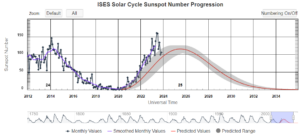
Progress and prediction for Solar Cycle 25, as expressed in numbers of sunspots, an indicator of heightened space weather conditions. Source NOAA
Heightened space weather activity brings some anxiety about how it could affect field operations. No one wants to face the prospects of having sent a crew or crews out for crucial work, only to find out that they may struggle due to apace weather conditions or may not be able to use GNSS for a day (or several days).
Encouraging news comes on several fronts. First, there are resources openly available for users to look for trends in space weather, predictive models, and in many cases live local status of conditions to help determine if symptoms they are experiencing may or may not be space weather related.
Second, manufacturers of high-precision receivers have developed, or are in the process of developing both base and rover-side solutions to help mitigate space weather conditions in real-time.
Third, the wide adoption of multiple constellations—and multi-signal processing—has markedly improved performance in all but the most extreme conditions. Network solutions already have a leg up; however, these will also see improvement.
What Is Space Weather and Why It Can Be A “Pain in the GNSS”?
A solar geomagnetic cycle is marked by increased sunspot activity, ejection of solar material, coronal loops, etc. One can go down a rabbit hole of terminology, though it is a fascinating subject. However, the key question that high-precision GNSS users have is: How will it impact my operations? This cycle is going to be a learning experience for many of us. I’m by no means an expert on this subject but have sought to point you to some helpful resources and have added insights from experts. I have to thank the GNSS engineers interviewed for their patience with me in explaining complex concepts.
Scientific entities, like the U.S. National Oceanic and Atmospheric Administration (NOAA) have resources to learn about space weather, status and predictions, and what to expect for various applications. We’ll be referring to those resources a lot in this article, as well as commercial and local resources. Keep this URL handy: spaceweather.gov. You will also find some informative Solar Cycle sites from Hexagon/NovAtel/Leica, Trimble, Topcon, and others.
NOAA details how GNSS can be affected. During heightened solar activity, the scientific community expresses, through various indices like the Kp Index, that there can be increases in total electron content (TEC). During heightened TEC, NOAA notes: “GPS systems cannot correctly model this dynamic enhancement and errors are introduced into the position calculations. This usually occurs at high latitudes, though major storms can produce large TEC enhancements at mid-latitudes as well.” Even more so at the geomagnetic equator (more on this later).
Another effect is “scintillation”. NOAA notes: “These smaller scale (tens of kilometers) instabilities, or bubbles, cause GPS signals to ‘scintillate’, much like waves on the surface of a body of water will disrupt and scatter the path of light as it passes through them. Near the equator, dual frequency GPS systems often lose their lock due to ‘ionospheric scintillation’. Ionospheric scintillations are not associated with any sort of space weather storm but are simply part of the natural day-night cycle of the equatorial ionosphere.” Scintillation is not limited to equatorial regions, just not experienced as much in other regions. This can be more common at dusk than other times of the day. NovAtel has a site that gives a good overview of scintillation and how it can affect GNSS.
During high-levels of such conditions, you may experience longer than usual initialization times, poor precisions (e.g., in decimeters), or periods of no solution at all. More specifically, you may experience significantly longer time to obtain fixed carrier phase ambiguities, fixed navigation solutions with increased precision estimates, be stuck in float or differential code solutions rather than fixed, biased fixed navigation solutions due to bad ambiguity fixing. It should be noted that newer gear can detect and reject a significant amount of these. However, if any of these, or combinations thereof occur, it couldmean lost productivity.
Alerts, Indexes, and Confusion
You may have signed up for email alerts from various space weather services. But how does something like a Kp Index, sunspot counts, or TEC values relate to symptoms your GNSS rover might experience? The various reporting methods are understood by and are invaluable to the scientific and highly specialized applications communities but can be puzzling to the average user.
Wouldn’t it be great to have a scale that was tailored specifically for GNSS applications? There already is!
In his 2004 paper “Ionospheric Disturbance Indices for RTK and Network RTK Positioning,” Dr.-Ing. habil. Lambert Wanninger, of the Geodetic Institute, Dresden University of Technology, examines what is called the “I95” ionospheric disturbance index.
I95 has been in use (in one form or another) since 1998 and has been implemented by many real-time GNSS networks (RTN) as an accessible resource for users. Not only is it implemented with scale values that can indicate various levels of rover symptoms, but it is also using live data from inclusive reference stations, to provide a local snapshot of the expected impacts. Whereas many space weather status resources are global or regional in nature, I95 (as implemented by for instance by an RTN) gives the user more of an idea of what might be happening in their immediate vicinity. This is not limited to RTN; there are tools for developing I95 from local reference station data, for example, WaSoft.
I95 can be computed for individual reference stations, or whole networks. Some RTN use several “sub-nets”, rather than a whole state or provincial network. Among the reasons for doing this can be varied plate velocity, weather profiles (tropospheric scaling), and to manage the effects of variations in ionospheric conditions. Iono impacts change throughout the day and can vary across broad areas.
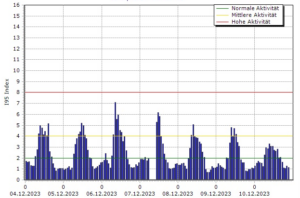
I95 example. Values over a week for the Thuringia (a state in Germany). Note the expected increase during the day, and calm at night. Source: Sapos.de
What do the I95 scale numbers indicate? As broadly implemented, by the scale numbers, you could expect:
- Below 2: Very low activity. No impact at all.
- Between 2 – 4: Normal activity. Very little impact.
- Between 4 – 8: Increased activity. Impact can be noticeable (possibly longer initialization times)
- Above 8: High activity. Impact very likely noticeable (possibly no rover fixes at all).
This provides current or past status—this is not a predictive tool—but you can leverage it to help plan ahead. On one level, you can look at the status over recent days to look for trends. However, the nature of space weather is that you could have a very bad day a followed by a calm one and so on. This is where noting your own experiences, and referring to the other indices comes into play.
Reading the Space Weather Tea Leaves
NOAA has an excellent GPS specific dashboard page with TEC, solar wind predictions, the status of the Aurora (that can be a harbinger for heightened solar activity) and Kp index. Combined with other data (more on that in this section), you can use it to look a bit into the future to help plan field operations.
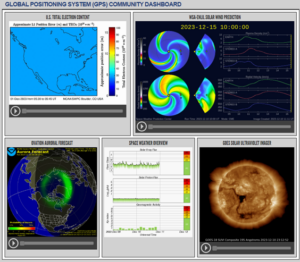
NOAA’s GNSS focused space weather dashboard.
There are a number of space weather reporting resources where you can look at present levels of say TEC and scintillation, and also look back days/weeks/months. One such example is the free online GNSS planning tool by Trimble found at: www.gnssplanning.com. This tool utilizes Trimble’s worldwide reference station network that is part of Trimble RTX. Not only does it have options for satellite availability planning, where you can choose your location and date/time in the future (based on published almanacs) to plan the best satellite availability, but it also allows you to view TEC and scintillation models that are created by the RTX server software and utilized by RTX services. Considering the cornucopia of GNSS satellites available today, many users no longer bother planning their GNSS missions based on satellite availability (though it was essential in the olde days of one constellation). However, given the potential impacts of Solar Cycle 25, it may be a good habit to begin planning your work again, and basing decisions on available TEC and scintillation data is a good start.
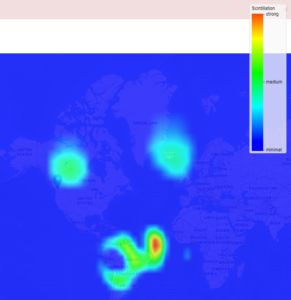
A TEC plot map (left) from the GNSS Planning Tool showing high values at the geomagnetic equator. Often you will see high values in the arctic and northern regions as well. Mid-latitude regions are not as frequently or intensely impacted. And a scintillation plot map (right) showing high values near the geomagnetic equator and mid-high values at northern latitudes.
For most space weather resources, you may only be able to look at the present and past; this can still be quite useful for planning. In the GNSS Planning Tool, you can see TEC and scintillation conditions (derived from a global tracking network) projected over a world map. You can even hit play and watch conditions as they progressed over time. Again, cool to see trends—the moving blobs and bubbles. But it is more valuable for you to correlate say TEC conditions at a point in time, with the values on the local I95 plot, and then with your memory of how your rover was behaving at that time. Users that experienced a particular symptom in the field can analyze these tools together and start developing rules-of-thumb for what conditions affect them, and in what way.
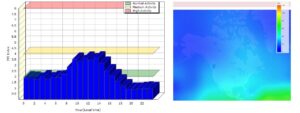
A normal space weather day. A modest rise in daytime I95 (left, from an RTN in the Pacific Northwest) and low TEC values (right, from the GNSS Planning Tool).
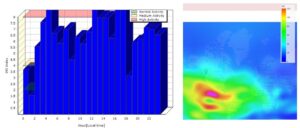
A rough space weather day. Mid-high daytime I95 (left, from an RTN in the Pacific Northwest) and mid-high TEC values (right, from the GNSS Planning Tool). Note that on this day, RTN users only reported slow initializations, but could eventually fix with mostly expected precisions.
Now compare the above values for the two different days conditions with a Kp Index Plot. By analyzing the TEC, scintillation, and I95 for your local region, plus your own experiences during those conditions, you can begin to get a handle on what various Kp Index values might portend for your future field operations planning. Many of the automated space weather alerts and prediction graphs are expressed as Kp values.
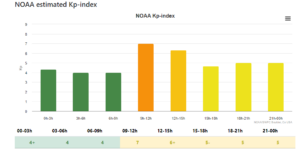
The NOAA Kp Index for their Boulder facility for December 1, 2023. Compare to the I95 and TEC plots for the Pacific Northwest example above for the same day.
Then, take this process a step further, into (sort of) prediction…
Prediction Resources
Space weather prediction resources online are often displaying global or broad regional trends. It can be a challenge to find something localized enough to develop your own rules-of-thumb.
It would be wonderful if there was a tool that told you exactly what the effects of space weather will be for your GNSS rover at exactly the place and time you intend to work, but there isn’t. The broad-brush predictive resources readily available can give you a rough idea. Once you have studied some archive and current status graphs, and compared the values to what you were experiencing at those times and locations, you’ll get a better handle on what to expect. You can do, as we’ve suggested, and look at Kp values, TEC, and I95 for your location on a particular day and think back to how your rover was performing.
For instance, during a period of Kp 6, and I95 of 7, what was the TEC at that time for your location? Were you experiencing longer than usual time to obtain a fixed solution? Were you unable to fix? Were the residuals unusually high? Find days where the Kp was at different levels, see what the corresponding I95 and TEC for your local region were, perhaps put these in a spreadsheet. You can develop some rules-of-thumb for factoring in space weather for your field operations.
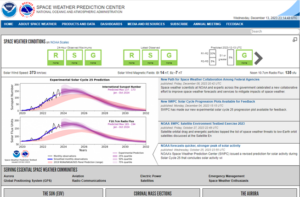
Dashboard of National Weather Service/NOAA Space Weather Prediction center site: www.swpc.noaa.gov
Another great resource from NOAA, is where you can look at their dashboard, and download a 3-day space weather prediction text file via this link. Note that you are seeing numeric values for Kp. Also, a recently launched Hexagon/NovAtel TEC tool shows the past seven days, plus three days ahead (based on the online archives of the Crustal Dynamics Data Information System (CDDIS), NASA Goddard Space Flight Center. The Hexagon/NovAtel tool has a handy slider bar, so you can see how the TEC levels progress over time. You can also zoom in and see what specific TEC values at a point in time looked like and might look like a few days ahead.
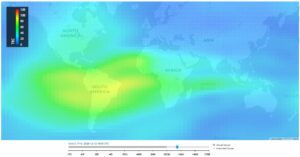
The Hexagon/NovAtel TEC tools, with a slider bar that goes back seven days and forward three days. You can zoom into a location and see the TEC values for a specific point in time.
Receiver-side Mitigation
Very recently, multiple manufacturers of high precision GNSS receivers have announced space weather resources, educational sites, and in some cases, solutions developed to run on the receiver to better model the effects of heightened space weather conditions. For example, Trimble, Hexagon/NovAtel, CHC Navigation, and Tersus GNSS.
I contacted several manufacturers to find out how the receiver solutions work and found out that such things had been in development long before this cycle began, prompted by experiences with pervious cycles. And that the maturing of multi-constellation and multi-signal processing has been a boon to such developments.
“I have been with Trimble for about 30 years; so, I’ve been here a while. I mainly look after the OEM business,” said Ed Norse, portfolio manager of Trimble’s GNSS OEM modules. “We sell to other OEMs, but that same technology is used in all our geospatial, construction, and agricultural receivers. Because we have a lot of customers in the mining industry in South America, where problems related to space weather can be the most extreme, we’ve been pushing for these solutions for a long time.” While there can be issues in northern Canada and Alaska, mainly this is a phenomena along the geomagnetic equator, which dips down around Brazil, Chile, Peru, etc. Surveyors and other users in the mid-latitudes may not feel the impact as much, but these developments will certainly benefit all users.”
“Our engineering group, which is managed by Stuart Riley, who I see you interviewed for that series about how rovers work, and his team, have done a lot of good work in the last couple of years updating our firmware. The team created a new feature called IonoGuard for our ProPoint technology to combat bad ionospheric conditions,“ said Norse. “This is very good timing, as the activity is increasing as expected, and it’s looking like this cycle is bigger than the last, maybe bigger than the last two, and possibly bigger than was predicted.”
Trimble just announced new firmware (6.23) with what they call IonoGuard that can be applied to any of their receivers that have the ProPoint technology inside (e.g., in recent years, like the R12, R12i, R580, R780, OEM products, etc.) Norse said that the previous firmware (6.21) had some limited IonoGuard functionality, but the full solution is in the latest version.
IonoGuard addressed the issue on two levels: in signal tracking and in RTK algorithms. “You may be familiar with our ProPoint technology, that’s something we introduced a couple of years ago,” said Norse. “The signal tracking, in terms of all those sats and signals, we can use any of the signals and are not reliant as much on L1 in the solution.” Older solutions typically had to have L1 in the solution. With the modernized receivers you may only need L1 to get an ephemeris, but once you have that you can be up and running on just about any combination of signals and could lose any individual signal but keep rolling. There are as many as 21 useable signals across the various constellations enabling 3rd signal processing, 4, 5, and combinations thereof.
“That helps us with the ionosphere that could be affecting one signal and not another,” said Norse. “The other main improvements are in the RTK engine. This is handled at the base, and the rover, working out the ionosphere levels and creating corrections. You can see benefits from just having it on the rover, but the best results come when you have it on both base and rover. We have proprietary messages in both RTCM and CMRx protocols, on a satellite-by-satellite basis. The information is sent to the rover, and the rover then uses those to weight the solution appropriately.”
In a way, they are addressing one of the fundamental limitations of base-rover RTK: degradation over distance. Over very short baseline lengths (i.e., a “site base” that can see from the rover) provides the best real-time results, However, as the distance between the base and rover increases, say to 10km or more, there will be degradation in performance. Yes, we can all tell tales of doing very-long-baseline RTK—20km, 30km, 50km, or more—but try to get repeatability over different days, different times of the day, and in varied space weather conditions. On a “bad iono” day, you may be lucky to get 10km, if at all. That is because, in legacy RTK, there is some level of the assumption of same conditions at both the base and rover. “Your base could be seeing different errors than the rover,” said Norse. “If you apply the same error model to the rover, you’re going to get inaccurate positions. That is why, without any weighting on the rover, you could see for instance, decimeter errors.”
“When you have two frequencies, you can kind of gauge what the iono and tropospheric delays are,” said Norse. “Then let’s say you’re multi constellation, even if you’re considering just the rover by itself, you’ve got all kinds of frequencies that you could use to come up with that. Now do that on the base as well—even better.” Now, by leveraging enhanced multi-signal tracking to work out the ionosphere on both the base and rover, you can get better performance over longer baselines in otherwise difficult iono conditions. It makes me wonder; will this improve longer baseline RTK even on good iono days? I’ll have to do some testing…
The next question is “what about networks?” In some ways, network solutions already had a leg up in modeling the ionosphere and troposphere (hence, the stations can be further apart). Bases, and network bases are typically in open sky and low-multipath environments, so those factors would not get mixed up in the evaluation of iono and tropo conditions. If network bases have ProPoint and have IonoGuard installed (or other solutions in the works for other types of bases), single base users of networks have the same benefits as with base-rover of course, and Norse says that the R&D teams are investigating potential benefits for the already iono happy network solutions.
With network solutions and precise point positioning (PPP) services, like RTX where a wide area model is applied, where you’re using the model, there can be differences. Think about how network and PPP services handle a station outage, or high ionosphere values; they can drop that specific data and still model effectively. “Maybe there’s a scintillation event or something like that. Generally speaking, unless you’re way out at the edge of a network, I don’t think that’s going to impact you on your network,” said Jason Evans, PLS, portfolio manager of Trimble Positioning Services. “With an RTX, or VRS solution, I think that we’re pretty confident that we were already seeing better performance than you would have had, let’s say, if you were in the middle of a scintillation event, or ionospheric, gradient event, than if you were using differential base-rover.”
Are there additional things that could be done to improve even further the already good modelling for PPP and network solutions with regards to space weather? Evans says yes, network bases can definitely benefit from the improved signal tracking and other aspects are in development.
While solutions like IonoGuard can effectively improve base and rover performance during periods of increased ionospheric activity, Evans explains that best practices are still important. “Plan your work, consider all of the tools that are available to you–including real-time networks and real-time PPP solutions, and if you feel like you have to use a base-rover workflow, be sure to give yourself the greatest opportunity for success by setting your base up in the best possible open-sky environment during the periods of the day with the least ionospheric interference, and be sure to keep your firmware up to date to gain access to new features like IonoGuard.” Norse noted that their receiver interfaces have another tool that can come in handy; a kind of color-coded “traffic light” system, indicating iono levels for each satellite observed. Got a particularly bad one? Drop it out of solution.
Cheden Huang, the director of research and development for Tersus GNSS, provided a technical explanation of their approach to addressing heightened space weather states, a solution they call SENTRY. This represents a series of technologies and methods they have applied to improve RTK/PPP reliability during ionosphere scintillation conditions.
“SENTRY is based on Tersus receivers’ scintillation indexes outputs, the indexes are similar to intensity scintillation index (S4), phase scintillation index (sigma-phi, known to academic circles), but with hardware support, “said Huang. “Receivers can do phase tracking sampling up to 200Hz and can output the indexes at multiple window widths (10s, 30s, 60s, etc.). These indexes are considered highly correlated to ionosphere scintillation events.”
Huang explained their four-level approach:
“First, rover RTK/PPP algorithm excluding/de-weighting/alerting satellites based on these indexes.
Second, the station outputs these indexes; this information can be used at the rover side for a single-base application or be used in network processing for a network solution (e.g., a VRS service).
The third involves a Tersus station network; the VRS algorithm can take advantage of these indexes (similar to RTK). An iono/scintillation status map can also be established. Another index (I95, ionospheric disturbance index based on differential ionospheric residues) is introduced. These information can be broadcast to rover side to assist the RTK algorithm.
The fourth involves networks and historical data. We can even do iono/scintillation prediction with big data. We’re exploring additional things we can do at the fourth level.”
Exercise Caution, But Don’t Panic
There is another lateral “hazard” to this solar cycle, what I call the “Vibe-o-spheric effect”: overlooking other possible issues by assuming that the cause is space weather. As a GNSS network operator, I sometimes get calls where a user sees a news item about some solar event, and they suspect it is causing their field difficulties. A quick look at status resources and letting them know that others are not reporting issues, the user might then take other troubleshooting steps (and find out it is often something else, like settings). There are other GNSS “vibe” effects, like users thinking that the constellation operators have suddenly moved the satellites around, or “is this LightSquared”? To be honest, the “vibe-o-sphere effect” prompted me to write this article. Yes, such effects can (and likely will at times) be significant, but let’s be diligent in troubleshooting.
In the previous solar cycle, some users carried a handheld recreational GPS unit for a gut check: if that was not getting a solution, their high-precision gear likely could not. Nowadays, that could be a bit misleading, as present day high-precision gear can use many other signals that might not be as heavily impacted as the L1 on that handheld. Multiple constellations and multiple-signal solutions are key to providing improved resilience in heightened space weather conditions.
The next few years may not be smooth sailing, but diligence, a little research, and new solutions can help us ride out the rough times.

